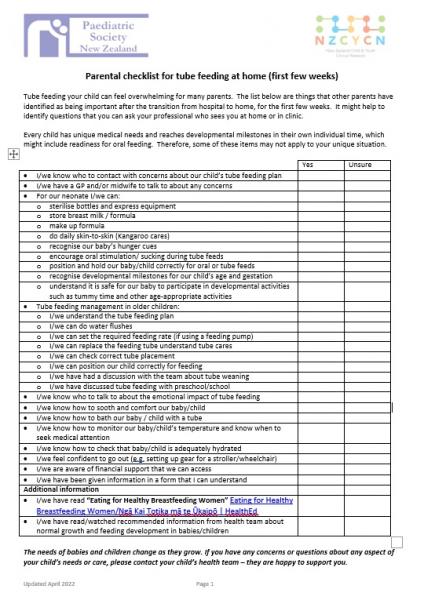Tube Feeding - Checklist For Tube Feeding At Home
Tube Feeding - Checklist For Tube Feeding At Home
Tube feeding your child can feel overwhelming for many parents. There are some things parents who have made the transition from tube feeding at hospital to tube feeding at home have identified as being important, especially in the first few weeks.
Parents can sometimes feel overwhelmed with tube feeding their child at home. There are some things parents whose tamariki have transitioned from hospital to home have identified as being important, especially in the first few weeks.
The following is a checklist identifying the things other parents have found important, or had questions about. You might find it helpful to come up with questions to ask your child's health professional, whether they see you at home or in a clinic.
Remember every child has their own medical needs and achieves things in their own individual time, which might include when they are ready to move to oral feeding. Therefore, some of the items on this checklist may not apply to your child's unique situation.
Find out more about tube feeding
View the list as a word document (DOCX, 133KB).
Check out tube feeding tips and tricks from families
Consider these questions and answer 'yes' or 'not sure'
- I/we know who to contact with concerns about our baby/child’s tube feeding plan
- I/we have a GP and/or midwife to talk to about any concerns
For our baby I/we can:
- sterilise bottles and express equipment
- store breast milk / formula
- make up formula
- do daily skin-to-skin (Kangaroo cares)
- recognise our baby’s hunger cues
- encourage oral stimulation/ sucking during tube feeds
- position and hold our baby/child correctly for oral or tube feeds
- recognise developmental milestones for our child’s age and gestation (the time between conception and birth)
- understand it is safe for our baby to participate in developmental activities such as tummy time and other age-appropriate activities
Tube feeding management in older children:
- I/we understand the tube feeding plan
- I/we can do water flushes
- I/we can set the required feeding rate (if using a feeding pump)
- I/we can replace the feeding tube
- I/we understand tube care
- I/we can check correct tube placement
- I/we can position our child correctly for feeding
- I/we have had a discussion with the team about tube weaning
- I/we have discussed tube feeding with preschool/school
Other things to consider:
- I/we know who to talk to about the emotional impact of tube feeding
- I/we know how to sooth and comfort our baby/child
- I/we know how to bath our baby/child with a tube
- I/we know how to monitor our baby/child’s temperature and know when to seek medical attention
- I/we know how to check that baby/child is adequately hydrated
- I/we feel confident to go out (e.g. setting up gear for a stroller/wheelchair)
- I/we are aware of financial support that we can access
- I/we have been given information in a form that I can understand
Additional information:
- I/we have read Eating for Healthy Breastfeeding Women
- I/we have read/watched recommended information from my child's health team about normal growth and feeding development in pēpi/tamariki
The needs of babies and children change as they grow. If you have any concerns or questions about any aspect of your baby/child’s needs or care, please ask the their health team - they are happy to support you and your child’s journey.
This page last reviewed 14 April 2022.
Do you have any feedback for KidsHealth?
If you have any feedback about the KidsHealth website, or have a suggestion for new content, please get in touch with us.
Email us now
